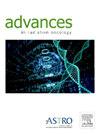Impacts of Intrafraction Virtual Reality-Based Environment Modification on Procedural Anxiety, Heart Rate, and Overall Radiation Therapy Experience During External Beam Radiation Therapy
IF 2.2
Q3 ONCOLOGY
引用次数: 0
Abstract
Purpose
Procedural anxiety of cancer treatments may negatively impact patients and treatments. Mindfulness-promoting environment modification with virtual reality (VR) is increasingly used across medicine to minimize procedural anxiety. We aimed to assess the impacts of intrafraction mindfulness-promoting VR use during external beam radiation therapy (EBRT) on radiation therapy experience and physiological measures of distress.
Methods and Materials
Adult patients receiving EBRT between May and October 2023 at our institution without contraindications to wearing VR were eligible. Participants had heart rates recorded before and after EBRT and completed a post-EBRT survey for 1 treatment without intervention, and 1 using VR. Participants completed the Radiotherapy Experience Questionnaire and additional questions regarding VR. Quantitative data were compared between conditions using paired samples t test.
Results
Fifty-two participants completed the project. Between pre- and post-EBRT, a significant decrease in heart rate with VR was noted (80.35 bpm vs 71.79 bpm; P < .0001*), but not in the control condition (78.90 bpm vs 78.10 bpm; P = .44). Post-EBRT heart rate was significantly lower with VR than without (71.79 bpm vs 78.10 bpm; P < .01*). Radiotherapy Experience Questionnaire responses showed participants had significantly lower situational unease (1.46 vs 2.02; P < .001*), a more beneficial situational response (1.55 vs 2.12; P < .01*), and improved environment acceptance (1.30 vs 1.60; P < .01*) when using VR. Most endorsed VR as comfortable (94%), improved treatment experience (86%), and would recommend it to others (86%).
Conclusions
We report the first evidence of the impacts of intrafraction mindfulness-promoting VR use during EBRT. Physiological measures of distress and patient perspectives suggest that VR can minimize procedural anxiety, is well tolerated, and improves the overall treatment experience. Further research should explore modifying this tool for patients unable to wear headsets and determining where the most clinically significant benefits can be found.
基于牵引内虚拟现实的环境改造对体外放射治疗过程中的程序焦虑、心率和整体放射治疗体验的影响
目的癌症治疗过程中的焦虑可能会对患者和治疗产生负面影响。医学界越来越多地使用虚拟现实技术(VR)来减轻治疗过程中的焦虑。我们的目的是评估在体外放射治疗(EBRT)过程中分段内使用促进意念的虚拟现实技术对放射治疗体验和痛苦的生理测量的影响。方法和材料2023年5月至10月期间在本院接受EBRT治疗的成人患者,无佩戴虚拟现实技术的禁忌症者均符合条件。参与者在 EBRT 之前和之后记录心率,并完成一次无干预治疗和一次使用 VR 治疗的 EBRT 后调查。参与者还填写了放疗体验问卷和有关 VR 的其他问题。采用配对样本 t 检验对不同条件下的定量数据进行比较。在 EBRT 前和 EBRT 后,使用 VR 的心率显著下降(80.35 bpm vs 71.79 bpm;P <;.0001*),但对照组的心率没有显著下降(78.90 bpm vs 78.10 bpm;P = .44)。使用 VR 的放疗后心率明显低于未使用 VR 的放疗后心率(71.79 bpm vs 78.10 bpm; P <.01*)。放疗体验问卷调查结果显示,使用 VR 时,参与者的情境不安感明显降低(1.46 vs 2.02;P <;.001*),情境反应更有益(1.55 vs 2.12;P <;.01*),环境接受度提高(1.30 vs 1.60;P <;.01*)。大多数人认为 VR 舒适(94%),改善了治疗体验(86%),并会向他人推荐(86%)。对痛苦的生理测量和患者的观点表明,VR 可以最大限度地减少治疗过程中的焦虑,具有良好的耐受性,并能改善整体治疗体验。进一步的研究应探索为无法佩戴耳机的患者修改这一工具,并确定在哪些方面可以找到最有临床意义的益处。
本文章由计算机程序翻译,如有差异,请以英文原文为准。
求助全文
约1分钟内获得全文
求助全文
来源期刊

Advances in Radiation Oncology
Medicine-Radiology, Nuclear Medicine and Imaging
CiteScore
4.60
自引率
4.30%
发文量
208
审稿时长
98 days
期刊介绍:
The purpose of Advances is to provide information for clinicians who use radiation therapy by publishing: Clinical trial reports and reanalyses. Basic science original reports. Manuscripts examining health services research, comparative and cost effectiveness research, and systematic reviews. Case reports documenting unusual problems and solutions. High quality multi and single institutional series, as well as other novel retrospective hypothesis generating series. Timely critical reviews on important topics in radiation oncology, such as side effects. Articles reporting the natural history of disease and patterns of failure, particularly as they relate to treatment volume delineation. Articles on safety and quality in radiation therapy. Essays on clinical experience. Articles on practice transformation in radiation oncology, in particular: Aspects of health policy that may impact the future practice of radiation oncology. How information technology, such as data analytics and systems innovations, will change radiation oncology practice. Articles on imaging as they relate to radiation therapy treatment.
 求助内容:
求助内容: 应助结果提醒方式:
应助结果提醒方式:


